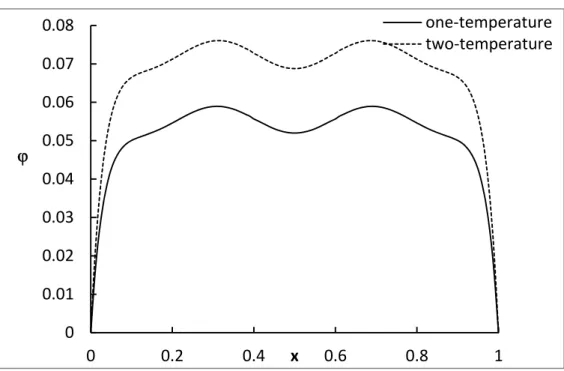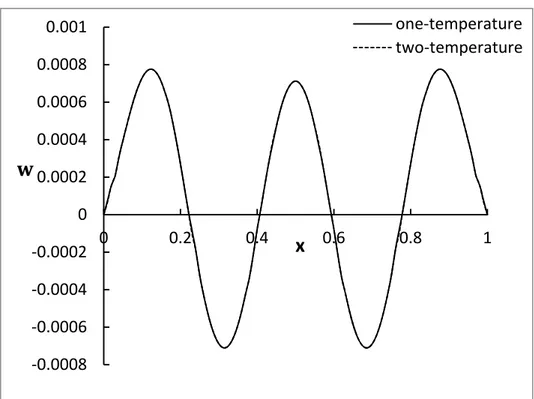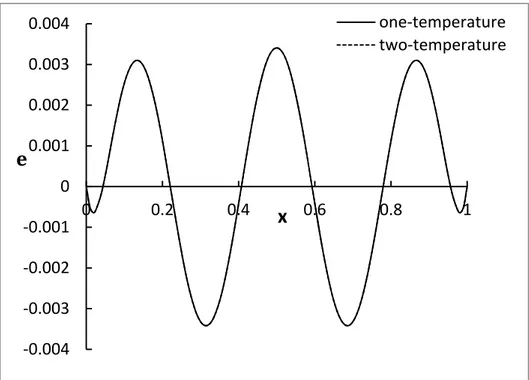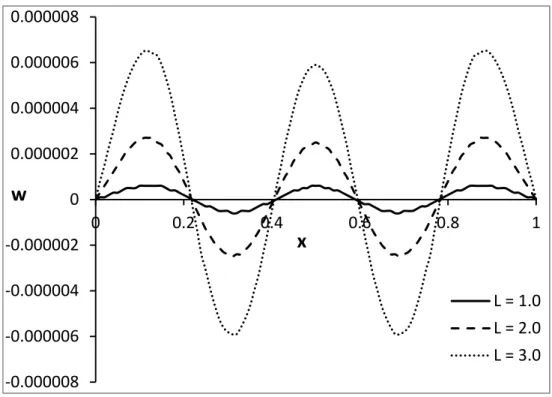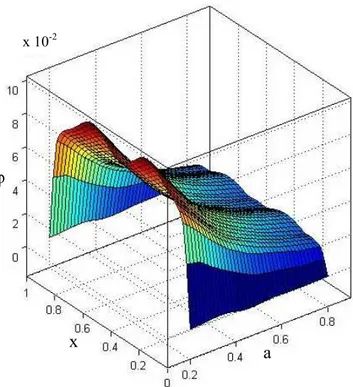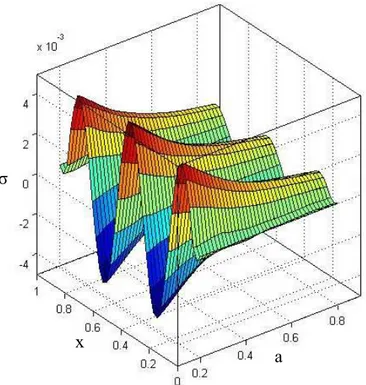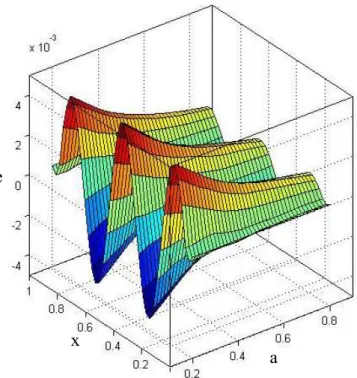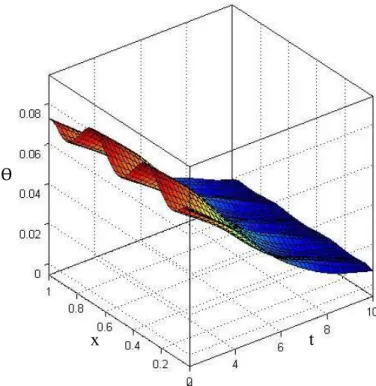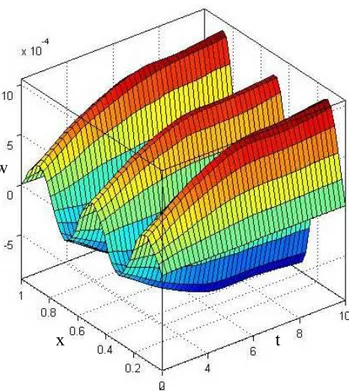Abstract
In the present work, the model of vibration of gold nano- beam induced by laser pulse heating is developed in the context of two-temperature generalized thermoelasticity and non-Fourier heat conduction. The analytic solution has been derived in the Laplace transform domain. The inverse Laplace transform has been calculated numerically and the numerical results have been presented graphically in two and three dimensions figures with some comparisons to stand on the effects of the two-temperature parameter and the laser pulse parameters on all the studying fields and which one of that parameters plays a vital role in the damping of the energy which has been generat-ed inside the beam.
Keywords
Two-temperature thermoelasticity, Euler–Bernoulli equation, gold nano-beam, state-space approach, laser pulse
Vibration of Gold Nano Beam in Context of Two-Temperature
Generalized Thermoelasticity Subjected to Laser Pulse
1 INTRODUCTION
With the rapid development of imaging technology, the perspectives of biomedical research have turned from subcellular structures in micro-scale (chromosomes, organelles, cytoskeleton, etc.) to biomolecules in nano-scale (nucleic acids, proteins, etc.). Studies on how bio macro molecules as-semble, coordinate, transmit signals, and execute function are very meaningful and important, be-cause they can facilitate the research on nano-biointeractions and promote the progress in biological detection, diagnosis and treatment techniques Wang et al. (2013).
Hamdy M. Youssef 12 a Alaa A. El-Bary 2b Khaled A. Elsibai c
a Faculty of Eng.-Mech. Dept.-Umm
Al-Qura Uni.-P.O. 5555-Makkah-Saudi Arabia
Math. Dep., Facu. Educ., Alexandria Univ. Egypt.
email: youssefanne2005@gmail.com
b Basic and Applied Science
Department-Arab Academy for Science and Techno-logy- Po. Box 1029-Alexandria, Egypt. email: aaelbary@aast.edu.
c Faculty of Appl. Sci.- Math. Dept.
Umm Al-Qura University-Makkah-Saudí Arabia.
email: drkhaledelsibai@yahoo.com
Received 23.02.2014 In revised form 09.04.2014 Accepted 14.04.2014 Available online 17.08.2014
Latin American Journal of Solids and Structures 11 (2014) 2460-2482 Gold Nano-Beams based nano-carriers have great potential in biomedical fields, such as biologi-cal monitoring, imaging, thermotherapy and multifunctional nano-complex diagnose, and all these bring ideas and hopes to the development of biomedicine. In connection with structure, property and bio-effects of Gold Nano-Beams, developing real-time, sensitive, high through put detection, and analysis methods could be the important consults to rational design of Gold Nano-Beams based nano-carriers. Ultimately, through surface modification and functionalization, it could improve tar-geting of Gold Beams, reduce immune response and other negative effects, these Gold Nano-Beams-based multifunctional nano-carriers will play crucial role in future biocatalysis, disease diag-nosis, imaging and therapy Wang et al. (2013).
Many works and articles have been made recently to investigate the elastic properties of nanostructured materials by atomistic simulations. Diao et. al. (2004) studied the effect of free sur-faces on the structure and elastic properties of gold nanowires by atomistic simulations. Although the atomistic simulation is a terrific way to calculate the elastic constants of nanostructured mate-rials, it is only applicable to homogeneous nanostructured matemate-rials, for example, nanoplates, nano-beams and nanowires with a limited number of atoms. Moreover, it is difficult to obtain the elastic properties of the heterogeneous nanostructured materials using atomistic simulations. For these and other reasons, it is prudent to seek a more practical approach. One such approach would be to ex-tend the classical theory of elasticity down to the nanoscale by including in it the hitherto neglected surface/interface effect. For this, it is necessary first to cast the latter within the framework of con-tinuum elasticity.
Latin American Journal of Solids and Structures 11 (2014) 2460-2482
Demir (2011) formulated the equations of motion and bending of Euler-Bernoulli beam using the nonlocal elasticity theory for cantilever microtubules (MTs).
Youssef and Elsibai (2010) investigated the vibration of gold nano- beam induced by many types of thermal loading. Youssef (2006) investigated two-temperature generalized thermoelasticity theory together with a general uniqueness theorem and solved many applications in the context of this theory with Al-Lehaibi (2007), Harby (2007) and Bassiouny (2008).
In this work, the model of vibration of gold nano- beam induced by laser pulse heating will be de-veloped in the context of two-temperature generalized thermoelasticity and non-Fourier heat con-duction. The analytic solution will be derived in the Laplace transform domain. The inverse Laplace transform will be calculated numerically and the numerical results will be presented graphically in two and three dimensions figures with some comparisons to stand on the effects of the two-temperature parameter and the laser pulse parameters on all the studying fields and which one of that parameters plays a vital role in the damping of the energy which will be generated inside the beam.
2 FORMULATION OF THE PROBLEM
Since beams with rectangular cross-sections are easy to fabricate, such cross-sections are commonly adopted in the design of NEMS beams. Consider small flexural deflections of a thin elastic beam of
length
0
x
, widthb
b
y
b
2
2
and thicknessh
h
h
z
2
2
, for which the x, y and z axes are defined along the longitudinal, width and thickness directions of the beam, respectively. In equilibrium, the beam is unstrained, unstressed, without damping mechanism, and the tempera-ture is T0 everywhere, Soh et al. (2008), Sun et al. (2006), Youssef and Elsibai (2010).In the present study, the usual Euler–Bernoulli assumption is adopted, i.e., any plane cross-section, initially perpendicular to the axis of the beam remains plane and perpendicular to the neu-tral surface during bending. Thus, the displacements
u , v , w
are given byFigure 1.
x
y
Latin American Journal of Solids and Structures 11 (2014) 2460-2482
w x, t
u
z
, v 0 , w x, y, z, t
w x, t
x
. (1)Hence, the differential equation of thermally induced lateral vibration of the beam may be ex-pressed in the form:
2
4 2
T T
4 2 2
M
w
A
w
0
x
EI
t
x
, (2)where E is Young’s modulus, I [= bh3/12] the inertial moment about x-axis,
the density of the beam,
T the coefficient of linear thermal expansion,w x, t
the lateral deflection, x thedis-tance along the length of the beam, A hb is the cross section area and t the time and
M
T is thethermal moment, which is defined as:
h / 2
T 3
h / 2
12
M
z dz
h
, (3)where
T T
0 is the dynamical temperature increment of the resonator, in which T(x, z, t) is the temperature distribution and T0 the environmental temperature.The Laser
pt t 0 2 p
I
I t
t e
,
t
(4)where
t
p is a characteristic time of the laser-pulse,I
0 is the laser intensity (the total energy car-ried by a laser pulse per unit cross-section of laser beam) Sun et al. (2006).The heat source
pt
z h / 2 z h / 2
t 0
2 p
I
1 R
1 R
Q z, t
e
I t
e
t e
,
t
(5)where
is the absorption depth of heating energy and R is the surface reflectivity.According to Youssef model of two-temperature thermoelasticity, the non-Fourier heat conduction equation has the following form:
p
t z h / 2
2 2 2
t
0 0
o o
2 2 2 2
p
C T 1 R I
e e 1 t e ,
x z t t k k t t
(6)
where
C
is the specific heat at constant volume,
0the thermal relaxation time, k the thermalconductivity,
E
T1 2
in which
is Poisson’s ratio,
is the conductive temperature incrementLatin American Journal of Solids and Structures 11 (2014) 2460-2482
2 2
2 2
,
x
z
(7)where
is non negative parameter (two-temperature parameter). The volumetric strain takes the formu
v
w
e
x
y
z
(8)Since there is no heat flow across the upper and lower surfaces of the beam, then,
0
z
z
atz
h / 2
(9)For a very thin beam and assuming the temperature varies in terms of a
sin pz
function along the thickness direction, wherep
/ h
, gives:
x, z, t
1
x, t sin pz
(10)and
x, z, t
1
x, t sin pz
(11)which gives
2 1 21 1 2
p
1x
(12)Hence, equation (2) gives
h / 2 2
4 2
T 1
4 2 3 2
h / 2
12
w
A
w
z sin pz dz
0
x
EI
t
h
x
(13)and equation (6) gives
p
2 2 2
2 0
1
1 o 1
2 2 2
t z h / 2
t 0
o 2
p
C
T
w
sin pz
p
sin pz
sin pz
z
x
t
t
k
k
x
I
1 R
e
1
t e
t
t
(14)After doing the integrations, equation (13) takes the form
2
4 2
T 1
4 2 2 2
24
w
A
w
0
x
EI
t
h
x
Latin American Journal of Solids and Structures 11 (2014) 2460-2482 In equation (14), we multiply the both sides by z and integrating with respect to z from
h
to
h
2
2
,then we obtain
pt 2
2 2 2
t
2 0
1
1 o 1 0 o
2 2 2
T
h
w
p
T
t
e
x
t
t
24k
x
(16)where p o
0
1/ a2
p p 0
t
1 R h I
C
,
,
2a 1 e
2a 1 , a
k
t
2 t T
h
Now, for simplicity we will use the following non-dimensional variables, Youssef (2008):
2
1 1 2o o p o o p 1 1 o
o o
1 1 E
x , w , c x, w, , t , , t c t, , t , , , , c
p p E T T
(17)
Then, we have
2
4 2
1
1 2
4 2 2
w
w
A
A
0
x
t
x
(18)
pt
2 2 2
t 1
3 1 o 1 4 o
2 2 2
w
A
A
t
e
x
t
t
x
(19)and
2 1
1 1
A
5 2A
6 1x
(20)where
2
2 2
t o
1 2 2 2 3 4 5 o 6 o
24
T
12
h
A
, A
, A
p , A
, A
c , A
c p
h
h
24k
(We have dropped the prime for convenience)
3 FORMULATION THE PROBLEM IN THE LAPLACE TRANSFORM DOMAIN
We will apply the Laplace transform for equations (18) - (20), which is defined by the following formula
s t0
f s
L f (t)
f t e
d t
Hence, we obtain the following system
2 4 2 1 1 2 4 2
d
d w
A s w
A
0
d x
d x
Latin American Journal of Solids and Structures 11 (2014) 2460-2482
2 2
p p o o
2 1
3 1 o 1 4 2
2 2
p
t
t
s
d
d w
A
s
s
A
d x
d x
t s 1
(22)and
2 11 6 1 5 2
d
1 A
A
d x
(23)We will consider the function
as follows:2
2
d w
d x
(24)Then, we have
2 2 2 1 1 2 2 2
d
d
A s w
A
d x
d x
(25)
2p p o o
2 2
1
3 1 o 1 4 o 2
2
p
t
t
s
d
A
s
s
A
s
s
d x
t s 1
(26)and
1 1 1 2 3
(27)where
2
4 5 o 5 p p o o
6 3 5
1 2 2 2 3 2 2
o 5 o 5 o 5 p
A A s
s
A t
t
s
1 A
A A
,
,
1
s
s
A
1
s
s
A
1
s
s
A
t s 1
Hence, we have
2 1
1 1 2 4
2
d
d x
(28) where
2
2
1
A
3 1s
os
,
2 2A
4s
os
p p o o
2
4 3 o 2
p
t
t
s
s
s
t s 1
Hence, we have
2 2
1 1 1 2 1 1 2 1 4
1 2
2 2 2 2 2 2 2 2
d
A
s
w
d x
1 A
1 A
1 A
1 A
(29)
2 2
2 1 2 2 1 2 1 2 1 2 2 1 4
1 1
2
2 2 2 2 2 2 2 2
A A
s
A
A
A
d
A s
w
d x
1 A
1 A
1 A
1 A
Latin American Journal of Solids and Structures 11 (2014) 2460-2482
2
3 4 1 5 5
2
d
w
d x
(31)where
2
2
1 2 2
3 1
2 2
A A s
A s
1 A
, 4
1 1 2
2 2
A
1 A
, 5
2 1 2
2 2
A
1 A
,
2 1 4 5 2 2
A
1 A
Finally, we have the system
2
2
d w
d x
(32)2
1 1 2 4
2
d
d x
(33)and
2
2 2
1
5 3 4
2 2 2
d
d
d
d x
d x
d x
(34)Eliminating
1 from equations (33) and (34), we get6 4 2
D
l D
m D
n
0
(35)Eliminating
from equations (33) and (34), we obtain6 4 2
1 3 4
D
l D
m D
n
(36)where r r r
d
D
d x
,l =
1 5 ,m =
1 5 2 4 3 andn =
1 3Now, we will consider the first end of the nano-beams x=0 is clamped and has no thermal load, which gives
1
w 0, t
0, t
0, t
0
(37)After using Laplace transform, the above conditions take the forms
1
w 0,s
0, s
0, s
0
(38)Considering the other end of the beam x is clamped and remains at zero increment of temper-ature as follows:
1
Latin American Journal of Solids and Structures 11 (2014) 2460-2482
1
w( ,s)
( ,s)
( ,s) 0
(40)After some simplifications, we get the final solutions in the Laplace transform domain as follows:
i i
3
x x
2
i 1 i i
i 1
a e
b e
(41)
i i
3
x x
4
1 2 i i
i 1 1
a e
b e
(42)
2
i i
3
i 1 x x
i i
2
i 1 i
w
a e
b e
(43)where
i, i
1, 2, 3
satisfy the following characteristic equation6 4 2
l
m
n = 0
(44)By using the boundary conditions, we get the following system of linear equations
3 2
i 1 i i
i 1
a
b
0
(45-a)
i i
3 2
i 1 i i
i 1
a e
b e
0
(45-b)
3
4
i i
i 1 1 2
a
b
(45-c)
i i
3
4
i i
i 1 1 2
a e
b e
(45-d)
2
3
i 1
i i
2
i 1 i
a
b
0
(45-e)
i i
2 3
i 1
i i
2
i 1 i
a e
b e
0
(45-f)Solving the above system, we get
i i
3
x x
2
i i 1
i 1
b
e
e
(46)
i i
3
x x
4
1 2 i
i 1 1
b e
e
Latin American Journal of Solids and Structures 11 (2014) 2460-2482
i i
2 3
i 1 i x x
2
i 1 i
b
w
e
e
(48) where
1
2 2 2
4 1 1 2 1 3
1 2 2 2 2 2
1 2 1 2 1 3
b
e
1
2
2 2 2
4 2 1 1 1 3
2 2 2 2 2 2
1 2 1 2 3 2
b
e
1
and
3
2 2 2
4 3 1 1 1 2
3 2 2 2 2 2
1 2 1 3 2 3
b
e
1
4 THE STRESS AND THE STRAIN-ENERGY
The stress on the x-axis, according to Hooke’s law is, Fang et al. (2006):
xx
x, z, t
E e
T
. (49)By using the non-dimensional variables in (9), we obtain the stress in the form
T 0
e
T
(50)After using Laplace transform, the above equation takes the form:
T 0
e
T
(51)The stress-strain energy which is generated on the beam is given by
3 ij iji, j 1
1
1
1
W x, z, t
e
e
z
2
2
2
(52)or, we can write as follows:
1
1
1
W x, z, t
z L
L
2
(53)where 1
Latin American Journal of Solids and Structures 11 (2014) 2460-2482 5 NUMERICAL INVERSION OF THE LAPLACE TRANSFORM
In order to determine the solutions in the time domain, the Riemann-sum approximation method is used to obtain the numerical results. In this method, any function in Laplace domain can be invert-ed to the time domain as Tzou (1996):
t N
n
n 1
e
1
i n
f (t)
f
Re
1 f
t
2
t
(54)where Re is the real part and
i
is imaginary number unit. For faster convergence, numerousnumer-ical experiments have shown that the value of
satisfies the relation
t
4.7
Tzou Tzou (1996).Numerical Results and Discussion
Now, we will consider a numerical example for which computational results are given. For this pur-pose, gold (Au) is taken as the thermoelastic material for which we take the following values of the different physical constants Youssef and Elsibai (2010):
k318 W / m K , T 14.2 10
6K 1
, 3
1930 kg / m
, T0293 K, C130 J / kg K
,E180 GPa , 0.44 .
The aspect ratios of the beam are fixed as
/ h
10
andb / h1 / 2 , when h is varied,
and bchange accordingly with h.
For the nanoscale beam, we will take the range of the beam length
91 100 10 m . The
orig-inal time t and the ramping time parameter
t
0 will be considered in the picoseconds
121 100 10 sec and the relaxation time
0 in the range
141 100 10 sec .
The figures were prepared by using the non-dimensional variables which are defined in (9) for beam length1.0 , z h / 6 andt5.0 .
Latin American Journal of Solids and Structures 11 (2014) 2460-2482
Figure 2: The heat conduction distribution.
Figure 3: The dynamical heat distribution.
0
0.01
0.02
0.03
0.04
0.05
0.06
0.07
0.08
0
0.2
0.4
0.6
0.8
1
x
one
‐
temperature
two
‐
temperature
0
0.01
0.02
0.03
0.04
0.05
0.06
0.07
0.08
0
0.2
0.4
0.6
0.8
1
x
one
‐
temperature
Latin American Journal of Solids and Structures 11 (2014) 2460-2482
Figure 4: The deflection distribution.
Figure 5: The stress distribution.
‐
0.0008
‐
0.0006
‐
0.0004
‐
0.0002
0
0.0002
0.0004
0.0006
0.0008
0.001
0
0.2
0.4
0.6
0.8
1
w
x
one
‐
temperature
two
‐
temperature
‐
0.005
‐
0.004
‐
0.003
‐
0.002
‐
0.001
0
0.001
0.002
0.003
0.004
0
0.2
0.4
0.6
0.8
1
x
Latin American Journal of Solids and Structures 11 (2014) 2460-2482
Figure 6: The strain distribution.
Figure 7: The strain-stress energy distribution.
‐
0.004
‐
0.003
‐
0.002
‐
0.001
0
0.001
0.002
0.003
0.004
0
0.2
0.4
0.6
0.8
1
e
x
one
‐
temperature
two
‐
temperature
‐
0.05
0
0.05
0.1
0.15
0.2
0.25
0
0.2
0.4
0.6
0.8
1
W
x
10
5x
Latin American Journal of Solids and Structures 11 (2014) 2460-2482
Figure 8: The deflection distribution with different values of length.
The two temperature parameter plays a vital role on the damping of the stress-strain energy where when this parameter increases that energy decreases.
Figure 8 shows the deflection distribution with different values length to stand on the effect of the scale of the beam on the deflection, and we found that, the length of the beam has a significant effect on its deflection, where the deflection increases when the length of the beam increases.
The figures 15-20 show the heat conduction distribution, the dynamical heat distribution, the de-flection distribution, the stress distribution, the strain distribution and the strain-stress energy dis-tribution respectively with constant value of the two temperature parameter and with different values of time to stand on the effect of the time on all the studied fields and we find out that, the time has significant effects on all the studied fields.
‐
0.000008
‐
0.000006
‐
0.000004
‐
0.000002
0
0.000002
0.000004
0.000006
0.000008
0
0.2
0.4
0.6
0.8
1
L
=
1.0
L
=
2.0
L
=
3.0
w
Latin American Journal of Solids and Structures 11 (2014) 2460-2482
Figure 9: The heat conduction distribution at t = 5.0.
Figure 10: The dynamical heat distribution at t = 5.0.
x
a
φ
x
a
ϴ
x 10-2
Latin American Journal of Solids and Structures 11 (2014) 2460-2482
Figure 11: The deflection distribution at t = 5.0.
Figure 12: The stress distribution at t = 5.0.
x
a
w
x
a
Latin American Journal of Solids and Structures 11 (2014) 2460-2482
Figure 13: The strain distribution at t = 5.0.
Figure 14: The strain-stress energy distribution at t = 5.0.
x
a
e
W
x
Latin American Journal of Solids and Structures 11 (2014) 2460-2482
Figure 15: The heat conduction distribution at a = 0.4.
Figure 16: The dynamical heat distribution at a = 0.4.
φ
x
t
x
t
Latin American Journal of Solids and Structures 11 (2014) 2460-2482
Figure 17: The deflection distribution at a = 0.4.
Figure 18: The stress distribution at a = 0.4.
x
t
w
x
t
Latin American Journal of Solids and Structures 11 (2014) 2460-2482
Figure 19: The strain distribution at a = 0.4.
Figure 20: The strain-stress energy distribution at a = 0.4.
x
t
e
W
x
Latin American Journal of Solids and Structures 11 (2014) 2460-2482 6 CONCLUSION
The two-temperature parameter has significant effects on the heat conduction temperature, the dynamical temperature, the stress and the stress-strain energy.
Increasing the value of the two-temperature parameter causes decreasing on the values of the stress strain energy which gives more damping of that energy.
The values of the time have significant effects on all the studied fields. The length of the beam has a significant effect on its deflection.
Acknowledgments
The authors are grateful for the supports for this work provided by the “Long-Term Comprehensive National Plan for Science, Technology and Innovation” through STU - Umm Al-Qura University by grant number 10-MAT1243-10.
References
AL-Huniti, N.S., AL-Nimr M.A. and Naij, M. (2001).Dynamic response of a rod due to a moving heat source under the hyperbolic heat conduction model, Journal of Sound and Vibration, 242: 629–640.
Bassiouny, E. and Youssef, H. M., (2008).Two-Temperature Generalized Thermopiezoelasticity of Finite Rod Sub-jected to Different Types of Thermal Loading, J. Thermal Stresses, 31: 233-245.
Boley, B. A. (1972). Approximate analyses of thermally induced vibrations of beams and plates, Journal of Applied Mechanics, 39: 212–216.
Civalek, Ö., Akgöz, B., (2010). Free vibration analysis of microtubules as cytoskeleton components: Nonlocal Euler-Bernoulli beam modeling, Scientia Iranica, 17(5): 367-375.
Civalek, Ö., Demir, C., (2011). Bending analysis of microtubules using nonlocal Euler-Bernoulli beam theory, App. Math. Model., 35(5): 2053-2067.
Diao, J. K., Gall, K. and Dunn, M. L. (2004). Atomistic simulation of the structure and elastic properties of gold nanowires, Journal of Mechanics and Physics of Solids, 52: 1935–1962.
Eringen, A.C., (1983). On differential equations of nonlocal elasticity and solutions of screw dislocation and surface waves, J. Appl. Phys., 54: 4703-4710.
Fang, D. N., Sun, Y.X. and Soh, A.K. (2006). Analysis of frequency spectrum of laser-induced vibration of mi-crobeam resonators, Chinese Physics Letters, 23 (6): 1554–1557.
Kidawa, J. (2003).Application of the Green functions to the problem of the thermally induced vibration of a beam, Journal of Sound and Vibration, 262: 865–876.
Liew, K.M. Hu Y.G., He, X.Q., (2008). Flexural wave propagation in single-walled carbon nanotubes. Journal of Computational and Theoretical Nanoscience, 5: 581-586.
Manolis, G. D. and Beskos, D.E. (1980).Thermally induced vibrations of beam structures, Computer Methods in Applied Mechanics and Engineering, 21: 337–355.
Soh A. K., Sun, Y. X. and Fang, D. (2008).Vibration of microscale beam induced by laser pulse,” Journal of Sound and Vibration, 311: 243–253.
Latin American Journal of Solids and Structures 11 (2014) 2460-2482
Sun, Y.X., Fang, D.N. and Soh, A.K. (2006).Thermoelastic damping in micro-beam resonators International Journal of Solids and Structures, 43: 3213–3229.
Tzou, D. (1996).Macro-to –micro heat transfer, Taylor & Francis, Washington DC.
Wang, X., Shao, M., Zhang, S., and Liu, X. (2013). Biomedical applications of gold nanorod-based multifunctional nano-carriers, Journal of Nanoparticles Research, 15:1892-1913.
Youssef, H. M. (2006).Theory of Two-Temperature Generalized Thermoelasticity, IMA J. App. Math., 71(3): 383-390.
Youssef, H. M. and AL-Harby, A. H. (2007). State-Space Approach of Two-Temperature Generalized Thermoelas-ticity of Infinite Body with a Spherical Cavity Subjected to Different Types of Thermal Loading, J. Archive of Appl. Mech., 77(9): 675-687.
Youssef, H. M. and AL-Lehaibi, E. A. (2007). State-space Approach of Two -Temperature Generalized Thermoelas-ticity of One Dimensional Problem, Int. J. Solid and Structure, 44: 1550-1562.
Youssef, H. M. and Elsibai, K. A. (2010).Vibration of Gold Nano-Beam Induced by Different Types of Thermal Loading- A State-Space Approach, J. Nanoscale and Microscale Thermophysical Engineering, 15(1): 48- 69.
